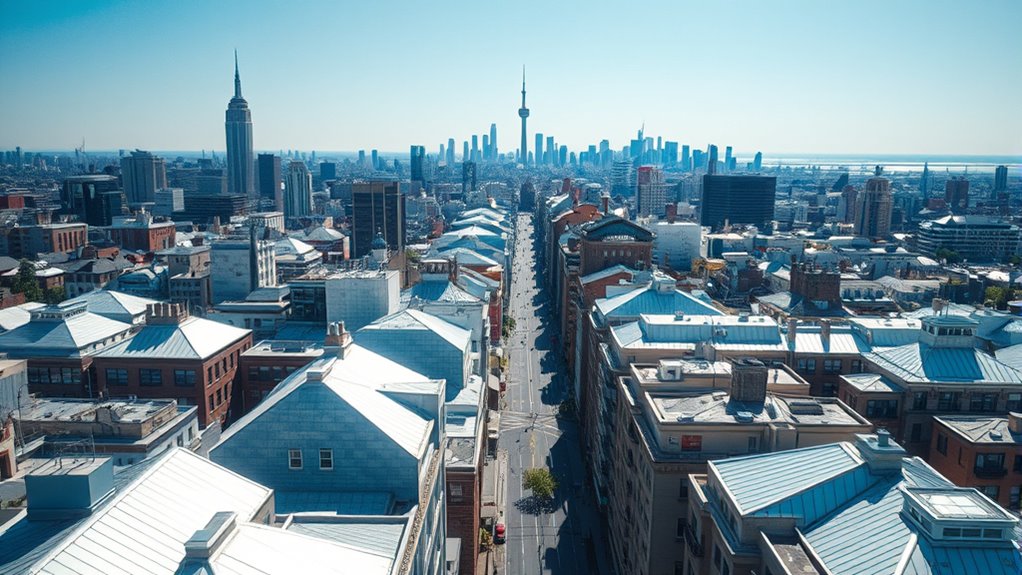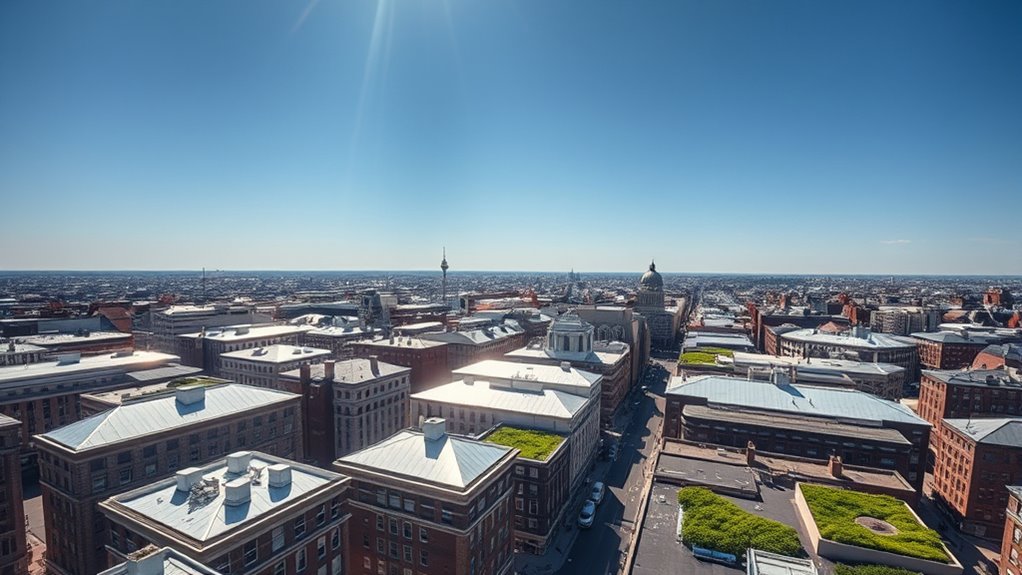Reflective roofs play a vital role in cooling cities by bouncing sunlight away, which reduces surface and air temperatures. When you install these high-solar-reflectance surfaces, they help prevent the urban heat island effect, making your environment more comfortable and energy-efficient. These roofs, often called cool roofs, work alongside green roofing and cool pavements to create healthier, more sustainable urban spaces. If you’re curious, there’s more to discover about how these strategies can transform your city.
Key Takeaways
- Reflective roofs bounce sunlight, reducing heat absorption and lowering building and urban temperatures.
- Cool roofs decrease the urban heat island effect by minimizing heat transfer from rooftops.
- Implementing high-albedo roofing materials helps cities stay cooler during heatwaves.
- Reflective roofs enhance energy efficiency by reducing cooling energy needs in buildings.
- Combining reflective roofs with other urban cooling strategies amplifies overall city temperature reduction.

Have you ever noticed how city streets seem warmer than surrounding rural areas, especially during summer? This phenomenon, known as the urban heat island effect, is caused by the way urban surfaces absorb and retain heat. Concrete, asphalt, and other traditional materials soak up sunlight during the day and release it slowly at night, creating a persistent warmth that makes cities uncomfortable and energy-intensive. But there are ways to combat this heat build-up, and two of the most effective strategies involve green roofing and cool pavements.
City streets often feel warmer than rural areas due to heat-absorbing surfaces like concrete and asphalt.
Green roofing involves installing vegetation on rooftops, transforming bare, heat-absorbing surfaces into lush, cooling environments. When you choose green roofs, you’re not just adding aesthetic value; you’re actively reducing indoor temperatures and lowering the surrounding air temperature. The plants provide shade and release moisture through transpiration, which cools the air much like natural forests do. This approach helps mitigate the urban heat island effect by decreasing the overall heat absorbed by buildings and streets. Plus, green roofs improve air quality and support biodiversity in densely populated areas.
Alongside green roofing, cool pavements offer another powerful tool to reduce urban heat. These specially designed surfaces have high solar reflectance, meaning they bounce much of the sunlight back into the atmosphere rather than absorbing it. When you opt for cool pavements for sidewalks, roads, and parking lots, you’re directly lowering the temperature of these surfaces. This not only makes walking and driving more comfortable but also lessens the heat transferred to the surrounding air. Implementing cool pavements is a practical way to make city streets less oppressive during heatwaves, reducing the demand for air conditioning and energy consumption.
Both green roofing and cool pavements work together to combat the heat island effect by decreasing the overall temperature of urban environments. Green roofs add a layer of natural cooling and ecological benefits, while cool pavements reflect sunlight and diminish heat absorption. When you consider incorporating these strategies into city planning or building projects, you’re taking tangible steps toward creating more livable, energy-efficient urban spaces. These solutions don’t just improve comfort—they also contribute to lowering greenhouse gas emissions and enhancing urban resilience against climate change. By making smart choices about roofing materials and pavement surfaces, you help transform cities from heat traps into cooler, healthier environments for everyone.
In addition, understanding the urban heat island effect is crucial for developing effective mitigation strategies that can be implemented at various scales, from small community projects to large-scale urban planning initiatives.
Frequently Asked Questions
How Long Do Reflective Roofs Typically Last?
Reflective roofs usually last around 10 to 20 years, depending on material durability and maintenance requirements. You should regularly inspect and clean the surface to preserve reflectivity and extend its lifespan. Materials like silicone or acrylic coatings tend to be more durable, but neglecting maintenance can shorten their effectiveness. Proper upkeep ensures your reflective roof stays functional longer, helping you maximize its cooling benefits and investment.
Are Reflective Roofs Cost-Effective for Homeowners?
Imagine you install a reflective roof on your home, and over time, you notice lower energy bills. Reflective roofs can be cost-effective for homeowners by providing significant cost savings on cooling costs, especially during hot summers. Plus, they offer aesthetic options that enhance your home’s appearance. While upfront costs vary, the long-term energy savings and environmental benefits often make reflective roofs a smart investment for your comfort and wallet.
Do Reflective Roofs Impact Indoor Temperature?
Reflective roofs can notably impact your indoor comfort by reducing heat transfer through your roof. As a result, your indoor temperature stays cooler, especially during hot days. This helps you enjoy a more comfortable home and can lead to energy savings, since you won’t have to rely as much on air conditioning. Overall, installing a reflective roof improves your indoor environment and lowers your energy bills.
Can Reflective Roofs Be Installed on Existing Buildings?
Imagine transforming an aging building into an energy-efficient marvel. You can install reflective roofs on existing structures through retrofits, aligning with urban planning policies that promote sustainability. While it’s more complex than new construction, it’s entirely possible to retrofit historical buildings with reflective materials. This approach helps reduce indoor temperatures and urban heat, making your city cooler and more livable without sacrificing its architectural charm.
Are There Environmental Drawbacks to Reflective Roofing?
You might wonder if reflective roofing has environmental drawbacks. While these roofs help reduce urban heat and energy use, their environmental impact depends on material sustainability. Some reflective coatings contain chemicals that can harm the environment during manufacturing or disposal, and not all materials are eco-friendly. As a result, it’s crucial to evaluate the environmental impact and choose sustainable materials to minimize negative effects on the environment.
Conclusion
By adopting reflective roofs, you can markedly reduce urban heat islands. For example, cities that implement cool roofs have seen temperatures drop by up to 2°C during heatwaves. This not only makes your environment more comfortable but also cuts energy costs and lowers pollution. So, when you choose reflective roofing, you’re helping cool your city and protect your community from rising temperatures, making urban living safer and more sustainable for everyone.









